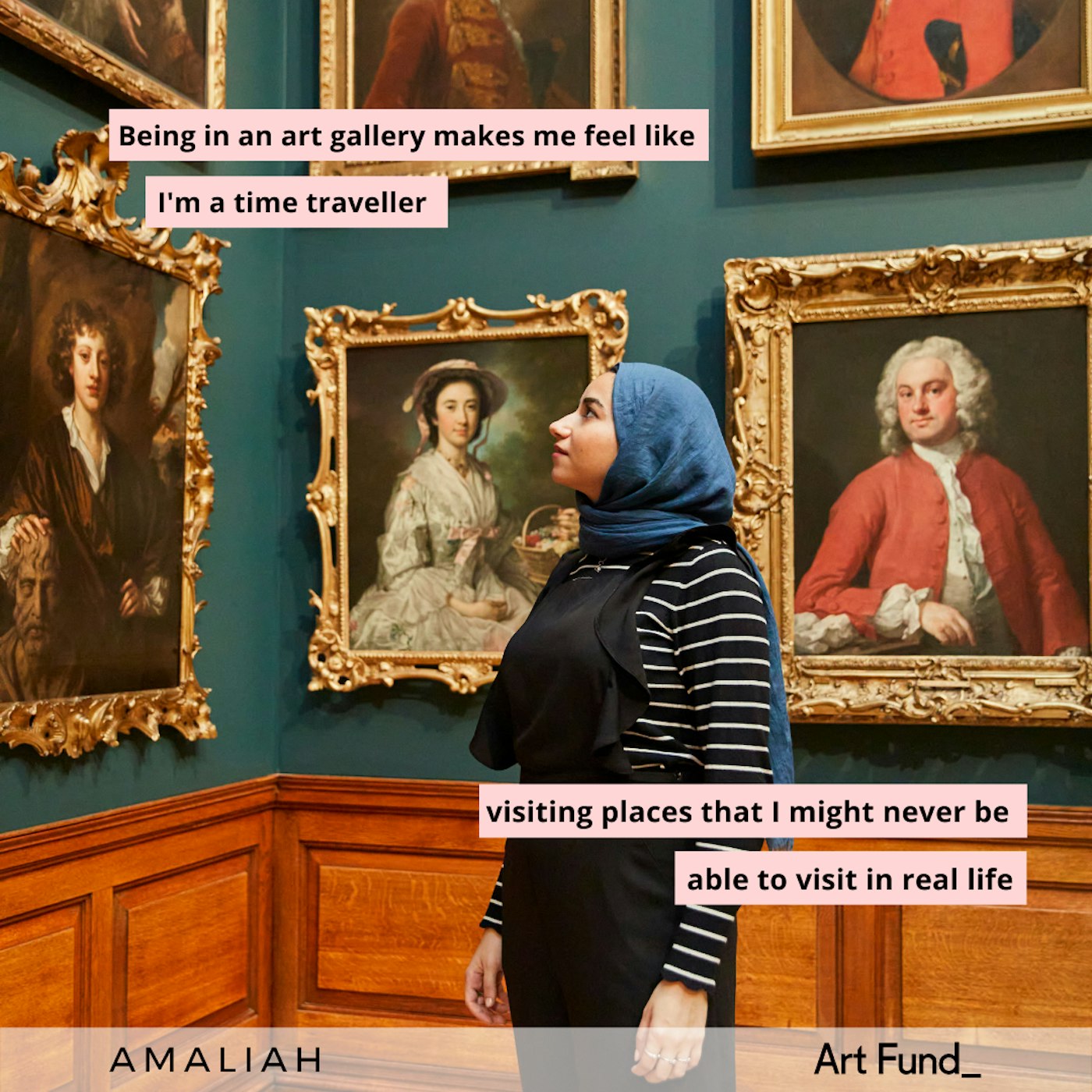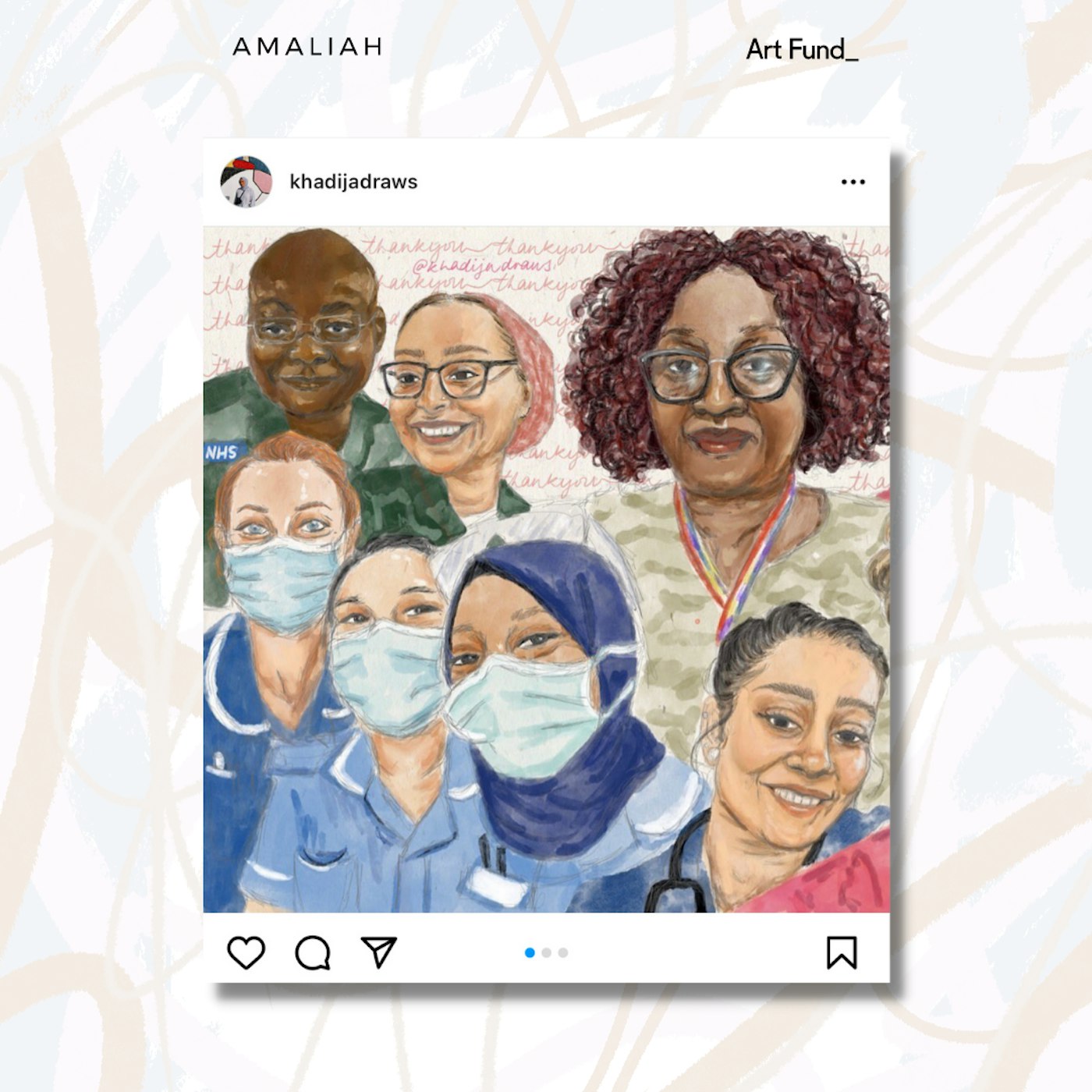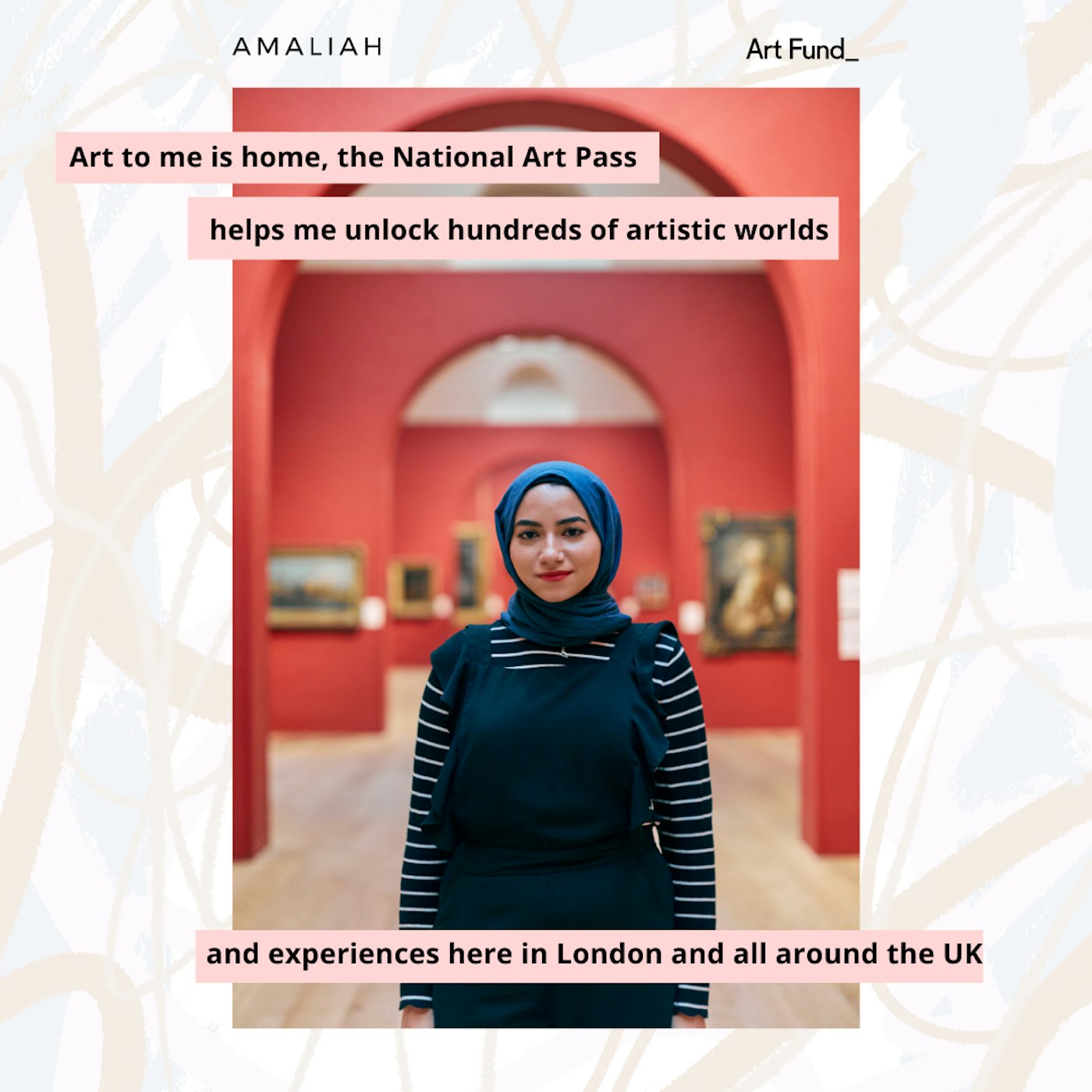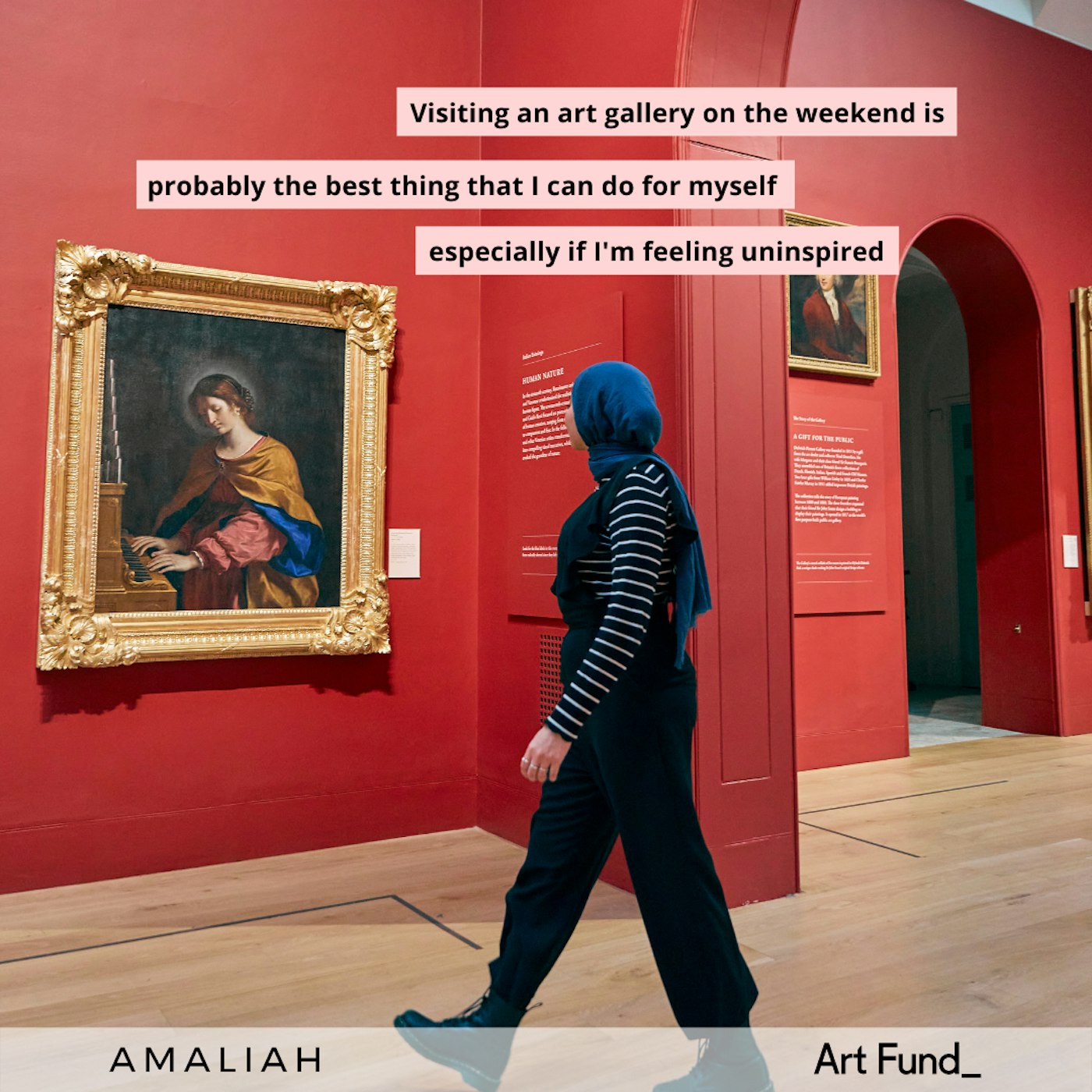Amaliah × National Art Pass Presents: In Conversation With Artist Khadija Said
by Amaliah Team in Culture & Lifestyle on 18th January, 2022

By day, Khadija Said works for a charity, by night and on weekends she can be found drawing and painting. Her art is defined by politics and portraits. She has often used her art as a means to raise awareness of a social issue be it Grenfell, BLM or human rights globally.
Amaliah sat down with Khadija in Dulwich Picture Gallery as a part of our ‘Spaces to_’ campaign with Art Fund to learn more about how she frequents museums and galleries which help her fill her creative cup, meet with friends and inspire her artistic craft.
Art Fund is the national charity for art that aims to ensure that as many people as possible can enjoy the UK’s museums and galleries. Art Fund’s National Art Pass gives you free entry to over 240 art-related attractions including museums, galleries and historic houses. Membership also includes Art Map, your comprehensive guidebook to using your pass, subscription to Art Quarterly magazine, as well as 50% off exhibitions across the UK! A perfect gift to yourself or your loved ones. Learn more about the National Art Pass here.
Khadija walks towards the centre of Dulwich Picture Gallery’s red room, carefully assessing each painting she passes on her way. Designed by Sir John Soane, Dulwich Picture Gallery is the world’s first known purpose-built public art gallery housing over 600 works of art.
She stops in front of one of the larger paintings in the main gallery space, Saint Jerome and a Donor. The natural light streaming in from the skylights in the room illuminates the details in the piece, highlighting the painting’s brushstrokes and gold frame.
“It’s these details that make visiting a gallery so special, you can’t see that level of detail if you look the painting up online.”
Khadija takes a seat on the bench placed in front of the painting and takes out a tablet and pencil from her bag. She begins illustrating the faces in the painting, paying attention to their features and expressions.
“Being in an art gallery makes me feel alive. It makes me feel electric, like I’m a time traveller. Like I can travel across 1000 different landscapes and meet 1000 different people and learn their stories, and visit places that I might never be able to visit in real life. Art to me is home and the National Art Pass is the key that helps me unlock hundreds of artistic worlds and experiences here in London and all around the UK.”

“I love staring at portraits and thinking about what the artist was thinking about at that time and whether they ever imagined that a woman in a hijab like me, hundreds of years later, would be staring back at their artwork, thinking about why they put their brushstrokes there, or what they wanted to tell the world. It feels so magical to be able to do all that in a single space.”
For Khadija, art plays an important role both on an individual as well as an institutional level. Through her art page on Instagram, Khadija explores the intersection of art and politics and frequently reflects on major political themes and events throughout her work.

“I started my art page a few years ago, and it was purely just to share with my friends the art that I was doing at the time. I had no intention of it really going any further. But I decided that I wanted to use that space to tap into my two big loves in life, which are politics and portraits. I wanted to talk about the current issues of the time, I wanted to express how I was feeling and the best way I knew how to do that was through art.”
One of the pieces Khadija is most proud to have worked on is her key workers digital collage.
“During the first lockdown, I put a simple call out asking key workers to send me their selfies, and that I would illustrate a few. I ended up getting hundreds of selfies from people all across the world. They were delivery drivers, they were teachers, they were NHS workers. I used that opportunity to put them all together in one big collage, even though they’d never met each other,” she explains.

“At that time, we were so isolated, and we all felt so alone. But that college was an opportunity for me to say thank you. And for us to all kind of be together in one big piece of art. I look back on that piece and it reminds me so much of that time, the devastation but also the hope and the togetherness that we felt even though we were physically so apart.”
Evoking emotions, marking important occasions and uniting people are some of the ways that Khadija utilises art in her work.
“I think art has so many different functions, it has so many different purposes. When I look at art, I think it’s a time capsule, it tells me so much about what was happening at a specific time, it tells me about politics, it tells me about history, it tells me about different movements. And it tells me about what someone was thinking and what someone was feeling without ever having exchanged a word with them, and that’s the real magic of art.”
The artists that inspire Khadija the most
- Van Gogh
- Dia Al Azzawi
- Banksy
- Faith Ringgold
- John Singer Sargent
- Kara Walker
- Artemisia Gentileschi
- Burhan Karkoutly
- Edward Hopper
Khadija points out a few of her favourite paintings in the gallery, explaining their history and what the artists intended to represent in each one. Mobile in hand, she snaps a picture of Rembrandt’s Girl at a Window to use as a reference for a drawing she is working on.

“Visiting an art gallery on the weekend is probably the best thing that I can do for myself to set myself up for the week, especially if I’m feeling uninspired. I don’t even realise it at the time, but I pour so much of what I’ve learned from visiting those spaces into my work in the day, drawing up new campaigns thinking about how to tell a story in a different way. And the same goes for the evenings in my illustrations, thinking about trying a new art technique that I’ve seen being used in a painting.”
“As an artist, I can’t imagine doing the work I do without visiting galleries and museums and without my National Art Pass. Like my art tools, I carry my National Art Pass with me everywhere I go. With it, I know I’m never far away from an inspiring experience or exhibition.”

Though Khadija emphasises the positive role of art as a tool to inspire and educate, she is keen to paint a fuller picture of the role that art has played in promoting certain narratives over others.
“My first memory of ever visiting an art and culture space was a school trip to the British Museum. I vividly remember walking into the room with all the Egyptian pharaohs and mummies and being in complete awe! I would turn around to anyone who would listen and say “This is Egyptian, this is my heritage, this is the history that my parents would tell me about!”
“I remember I was really young at the time and staring at something that I thought would be the oldest thing that I’d ever see in my life and feeling completely amazed by it. But now that I’m older, and I’ve been back to spaces like the British Museum with an understanding of how those ancient artefacts were ripped away from their original settings and contexts and how that art came to be in that space, it completely changes the way that you view that art and the way that you understand it.”
“It became really important for me to explore that intersection in my own artwork. Because without factoring in the politics, and without looking at art in its societal context, everything becomes 2D or warped. We will never see or understand what the artist intended.”

“Curation is just as important as the creation of the art. When we visit art galleries, I think it’s important to keep in mind the visible as well as the invisible and by that I mean who gets to be exhibited and who doesn’t. Which art is deemed valuable and celebrated and which art isn’t. Art doesn’t exist in a vacuum and it is informed as much by politics as it is by aesthetics.“
Khadija takes a break from her sketch to stroll around some of the temporary exhibitions currently showing, and to admire the central viewpoint in the gallery’s main exhibition space.
“When people think of art galleries, they often imagine dark, stuffy rooms with dusty paintings, and they imagine that only a specific type of person can be in that space and understand the art on display, but to me, galleries and museums are spaces to do more, to be more and to see more. They are spaces to be creative, to be free, to make mistakes, and to learn and to come up with new ideas. These spaces are yours to explore and make your own.”

Khadija’s favourite art galleries
- National Portrait Gallery
- Tate Modern
- Guildhall Art Gallery
- The Courtauld Gallery
- Barbican Art Gallery
For Khadija, the presence of art spaces and who has been allowed to exist within them is inherently political,

“For centuries, art and culture spaces were designed to exclude so our very existence in these spaces is a revolutionary act because it pushes back against that culture of exclusion. There are no rules to how you can understand or appreciate art, and that’s the beauty of it. I love being able to do that specifically as a digital artist, looking at a traditional painting and thinking about all the different ways that I can replicate and reimagine a pattern or technique using digital tools.”
“What makes art spaces valuable is not the art hanging on the walls. It’s the people interacting with that art, which is why our presence in these spaces is so necessary and so important.”
This article is sponsored by the Art Fund – learn more about the National Art Pass here. Every now and then we partner with companies to bring you sponsored content. We always strive to ensure we maintain the same editorial integrity that keeps you engaged in our non-sponsored content. We thank you for your support.
Amaliah Team
This article was written by a member of the Amaliah team or a collective team effort. You can follow us on @amaliah_tweets for the latest or head over to our Instagram @amaliah_com. If you're reading this and are thinking about contributing an article then send us an email with a brief or a full article to contribute@amaliah.com
